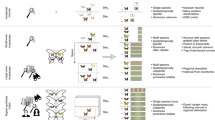Abstract
Effective ecological monitoring is imperative in a human-dominated world, as our ability to manage functioning ecosystems will depend on understanding biodiversity responses to anthropogenic impacts. Yet, most monitoring efforts have either been narrowly focused on particular sites, species and stressors — thus inadequately considering the cumulative effects of multiple, interacting impacts at scales of management relevance — or too unfocused to provide specific guidance. We propose a cumulative effects monitoring framework that integrates multi-scaled surveillance of trends in biodiversity and land cover with targeted evaluation of hypothesized drivers of change. The framework is grounded in a flexible conceptual model and uses monitoring to generate and test empirical models that relate the status of diverse taxonomic groups to the nature and extent of human “footprint” and other landscape attributes. An adaptive cycle of standardized sampling, model development, and model evaluation provides a means to learn about the system and guide management. Additional benefits of the framework include standardized data on status and trend for a wide variety of biodiversity elements, spatially explicit models for regional planning and scenario evaluation, and identification of knowledge gaps for complementary research. We describe efforts to implement the framework in Alberta, Canada, through the Alberta Biodiversity Monitoring Institute, and identify key challenges to be addressed.



Similar content being viewed by others
References
ABMI (Alberta Biodiversity Monitoring Institute). (2012a). Manual for Reporting Human Footprint, version 2012–03–26. Alberta Biodiversity Monitoring Institute, Alberta, Canada. Available at www.abmi.ca/ (accessed March 2013).
ABMI (Alberta Biodiversity Monitoring Institute). (2012b). Terrestrial field data collection protocols (abridged version) 2012–06–27. Alberta Biodiversity Monitoring Institute, Alberta, Canada. Available at www.abmi.ca/ (accessed March 2013).
ABMI (Alberta Biodiversity Monitoring Institute). (2012c). The Status of Landbirds in Alberta’s Boreal Plains Ecozone: Preliminary Assessment. Version 2011–12. Alberta Biodiversity Monitoring Institute, Alberta, Canada. Available at www.abmi.ca/ (published September 2012).
Barnosky, A. D., Hadly, E. A., Bascompte, J., Berlow, E. L., Brown, J. H., Fortelius, M., et al. (2012). Approaching a state shift in Earth's biosphere. Nature, 486, 52–58.
Bayne, E., Van Wilgenburg, S., Boutin, S., & Hobson, K. (2005). Modeling and field-testing of Ovenbird (Seiurus aurocapillus) responses to boreal forest dissection by energy sector development at multiple spatial scales. Landscape Ecol, 20, 203–216.
Boutin, S., Haughland, D. L., Schieck, J., Herbers, J., & Bayne, E. (2009). A new approach to forest biodiversity monitoring in Canada. For Ecol Manage, 258, S168–S175.
Burnham, K. P., & Anderson, D. R. (2002). Model selection and multimodel inference (2nd ed.). New York: Springer.
Butchart, S. H. M., Walpole, M., Collen, B., van Strien, A., Scharlemann, J. P. W., Almond, R. E. A., et al. (2010). Global biodiversity: indicators of recent declines. Science, 328, 1164–1168.
Castilla, G., Linke, J., McLane, A. J., & McDermid, G. J. (2011). Quantifying bias in pattern indices extracted from spatially offset landscape samples. Can J For Res, 41, 2090–2096.
DeWan, A. A., & Zipkin, E. F. (2010). An integrated sampling and analysis approach for improved biodiversity monitoring. Environ Manage, 45, 1223–1230.
Duinker, P., & Greig, L. (2006). The impotence of cumulative effects assessment in Canada: ailments and ideas for redeployment. Environ Manage, 37, 153–161.
Elith, J., Leathwick, J. R., & Hastie, T. (2008). A working guide to boosted regression trees. J Anim Ecol, 77, 802–813.
Environment Canada (2011). Integrated monitoring plan for the oil sands: terrestrial biodiversity component. Ottawa: Government of Canada.
Forman, R., & Alexander, L. (1998). Roads and their major ecological effects. Annu Rev Ecol System, 29, 207–231.
Franklin, J. (2009). Mapping species distributions: spatial inference and prediction. Cambridge: Cambridge University Press.
Giesy, J. P., Anderson, J. C., & Wiseman, S. B. (2010). Alberta oil sands development. Proc Natl Acad Sci, 107, 951–952.
Gitzen, R. A., Millspaugh, J. J., Cooper, A. B., & Licht, D. S. (Eds.). (2012). Design and analysis of long-term ecological monitoring studies. Cambridge: Cambridge University Press.
Government of Alberta. (2008). Land-use framework. Canada: Edmonton.
Government of Alberta. (2012). About Alberta. http://alberta.ca/aboutalberta.cfm (accessed March 2012).
Haines, A. M., Leu, M., Svancara, L. K., Scott, J. M., & Reese, K. P. (2008). A theoretical approach to using human footprint data to assess landscape level conservation efforts. Conserv Lett, 1, 165–172.
Haughland, D. L., Hero, J. M., Schieck, J., Castley, J. G., Boutin, S., Solymos, P., et al. (2010). Planning forwards: biodiversity research and monitoring systems for better management. Trends Ecol Evol, 25, 199–200.
Hill, D., & Arnold, R. (2012). Building the evidence base for ecological impact assessment and mitigation. J Appl Ecol, 49, 6–9.
Hooper, D. U., Adair, E. C., Cardinale, B. J., Byrnes, J. E. K., Hungate, B. A., Matulich, K. L., et al. (2012). A global synthesis reveals biodiversity loss as a major driver of ecosystem change. Nature, 486, 105–108.
Johnson, C. J. (2011). Regulating and Planning for Cumulative Effects: The Canadian Experience. In P. R. Krausman & L. K. Harris (Eds.), Cumulative effects in wildlife management: impact mitigation (pp. 29–46). Boca Raton, FL: CRC Press.
Johnson, D. H. (2012). Monitoring that matters. In R. A. Gitzen, J. J. Millspaugh, A. B. Cooper, & D. S. Licht (Eds.), Design and analysis of long-term ecological monitoring studies (pp. 55–73). Cambridge: Cambridge University Press.
Johnson, D., Lalonde, K., McEachern, M., Kenney, J., Mendoza, G., Buffin, A., & Rich, K. (2011). Improving cumulative effects assessment in Alberta: regional strategic assessment. Environ Impact Assess Rev, 31, 481–483.
Latham, A. D., Latham, M. C., Boyce, M. S., & Boutin, S. (2011). Movement responses by wolves to industrial linear features and their effect on woodland caribou in northeastern Alberta. Ecol Appl, 21, 2854–2865.
Laurance, W. F., Lovejoy, T. E., Vasconcelos, H. L., Bruna, E. M., Didham, R. K., Stouffer, P. C., et al. (2002). Ecosystem decay of Amazonian forest fragments: a 22-year investigation. Conserv Biol, 16, 605–618.
Lele, S. R., Moreno, M., & Bayne, E. (2012). Dealing with detection error in site occupancy surveys: what can we do with a single survey? J Plant Ecol, 5, 22–31.
Lindenmayer, D., & Likens, G. (2010). Effective ecological monitoring. Collingwood: CSIRO Publishing.
Lindenmayer, D., Hobbs, R. J., Montague-Drake, R., Alexandra, J., Bennett, A., Burgman, M., et al. (2008). A checklist for ecological management of landscapes for conservation. Ecol Lett, 11, 78–91.
Liu, J., Dietz, T., Carpenter, S. R., Alberti, M., Folke, C., Moran, E., et al. (2007). Complexity of coupled human and natural systems. Science, 317, 1513–1516.
Lookingbill, T. R., Schmit, J. P., & Carter, S. L. (2012). GRTS and graphs: monitoring natural resources in urban landscapes. In R. A. Gitzen, J. J. Millspaugh, A. B. Cooper, & D. S. Licht (Eds.), Design and analysis of long-term ecological monitoring studies (pp. 362–380). Cambridge: Cambridge University Press.
Lyons, J. E., Runge, M. C., Laskowski, H. P., & Kendall, W. L. (2008). Monitoring in the context of structured decision-making and adaptive management. J Wildl Manage, 72, 1683–1692.
Manley, P. N., Zielinski, W. J., Schlesinger, M. D., & Mori, S. R. (2004). Evaluation of a multiple-species approach to monitoring species at the ecoregional scale. Ecol Appl, 14, 296–310.
Nelson, E., Mendoza, G., Regetz, J., Polasky, S., Tallis, H., Cameron, D. R., et al. (2009). Modeling multiple ecosystem services, biodiversity conservation, commodity production, and tradeoffs at landscape scales. Front Ecol Environ, 7, 4–11.
Nichols, J. D., & Williams, B. K. (2006). Monitoring for conservation. Trends Ecol Evol, 21, 668–673.
Nielsen, S. E., Bayne, E. M., Schieck, J., Herbers, J., & Boutin, S. (2007). A new method to estimate species and biodiversity intactness using empirically derived reference conditions. Biol Conserv, 137, 403–414.
Nielsen, S. E., Haughland, D. L., Bayne, E., & Schieck, J. (2009). Capacity of large-scale, long-term biodiversity monitoring programmes to detect trends in species prevalence. Biodivers Conserv, 18, 2961–2978.
Noon, B. R., Murphy, D. D., Beissinger, S. R., Shaffer, M. L., & Dellasala, D. (2003). Conservation planning for US National Forests: conducting comprehensive biodiversity assessments. Bioscience, 53, 1217–1220.
Peters, D. P. C., Groffman, P. M., Nadelhoffer, K. J., Grimm, N. B., Collins, S. L., Michener, W. K., & Huston, M. A. (2008). Living in an increasingly connected world: a framework for continental-scale environmental science. Front Ecol Environ, 6, 229–237.
Roloff, G., & Kernohan, B. (1999). Evaluating reliability of habitat suitability index models. Wildl Soc Bull, 27, 973–985.
Rooney, R. C., Bayley, S. E., & Schindler, D. W. (2012). Oil sands mining and reclamation cause massive loss of peatland and stored carbon. Proc Natl Acad Sci, 109, 4933–4937.
Sanderson, E. W., Jaiteh, M., Levy, M. A., Redford, K. H., Wannebo, A. V., & Woolmer, G. (2002). The human footprint and the last of the wild. Bioscience, 52, 891–904.
Schneider, R., & Dyer, S. (2006). Death by a thousand cuts: impacts of in situ oil sands development on Alberta’s boreal forest. Edmonton: Pembina Institute and Canadian Parks and Wilderness Society.
Schultz, C. (2010). Challenges in connecting cumulative effects analysis to effective wildlife conservation planning. Bioscience, 60, 545–551.
Schwenk, W. S., & Donovan, T. M. (2011). A multispecies framework for landscape conservation planning. Conserv Biol, 25, 1010–1021.
Smart, S. M., Henrys, P. A., Purse, B. V., Murphy, J. M., Bailey, M. J., & Marrs, R. H. (2012). Clarity or confusion? Problems in attributing large-scale ecological changes to anthropogenic drivers. Ecol Indicators, 20, 51–56.
Sólymos, P., Matsuoka, S. M., Bayne, E. M., Lele, S. R., Fontaine, P., Cumming, S. G., et al. (2013). Calibrating indices of avian density from non-standardized survey data: making the most of a messy situation. Methods Ecol Evol. doi:10.1111/2041-210X.12106.
Sorensen, T., McLoughlin, P. D., Hervieux, D., Dzus, E., Nolan, J., Wynes, B., & Boutin, S. (2008). Determining sustainable levels of cumulative effects for boreal caribou. J Wildl Manage, 72, 900–905.
Stadt, J. J., Schieck, J., & Stelfox, H. A. (2006). Alberta Biodiversity Monitoring Program: monitoring effectiveness of sustainable forest management planning. Environ Monit Assess, 121, 33–46.
Steffen, W., Persson, A., Deutsch, L., Zalasiewicz, J., Williams, M., Richardson, K., et al. (2011). The Anthropocene: from global change to planetary stewardship. Ambio, 40, 739–761.
Timoney, K., & Lee, P. (2001). Environmental management in resource-rich Alberta, Canada: first world jurisdiction, third world analogue? J Environ Manage, 63, 387–405.
Vackar, D., ten Brink, B., Loh, J., Baillie, J. E. M., & Reyers, B. (2012). Review of multispecies indices for monitoring human impacts on biodiversity. Ecol Indicators, 17, 58–67.
Walters, C. J., & Holling, C. S. (1990). Large-scale management experiments and learning by doing. Ecology, 71, 2060–2068.
Wintle, B. A., Runge, M. C., & Bekessy, S. A. (2010). Allocating monitoring effort in the face of unknown unknowns. Ecol Lett, 13, 1325–1337.
Zuur, A. F., Ieno, E. N., Walker, N. J., Saveliev, A. A., & Smith, G. M. (2009). Mixed effects models and extensions in ecology with R. New York: Springer.
Acknowledgements
We thank D. Stralberg, R. Serrouya, J. Nichols, three anonymous reviewers and members of the Boutin-Bayne laboratory at the University of Alberta for comments on previous drafts of this manuscript.
Author information
Authors and Affiliations
Corresponding author
Rights and permissions
About this article
Cite this article
Burton, A.C., Huggard, D., Bayne, E. et al. A framework for adaptive monitoring of the cumulative effects of human footprint on biodiversity. Environ Monit Assess 186, 3605–3617 (2014). https://doi.org/10.1007/s10661-014-3643-7
Received:
Accepted:
Published:
Issue Date:
DOI: https://doi.org/10.1007/s10661-014-3643-7




